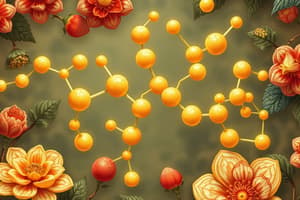Podcast
Questions and Answers
What are the components of triglycerides?
What are the components of triglycerides?
- Fatty acids and ribose
- Nucleic acids and ribose
- Fatty acids and glycerol (correct)
- Amino acids and glycerol
What is the function of DNA?
What is the function of DNA?
- Transmitting genetic information into proteins
- Acting as cofactors in enzymatic reactions
- Regulating calcium levels
- Storing genetic information (correct)
Which nutrients are absorbed through passive diffusion or active transport processes?
Which nutrients are absorbed through passive diffusion or active transport processes?
- Lipids (correct)
- Minerals
- Vitamins
- Carbohydrates
What do carbohydrates get converted into for use as an immediate source of energy?
What do carbohydrates get converted into for use as an immediate source of energy?
How are proteins broken down for absorption?
How are proteins broken down for absorption?
What role do minerals play in the body?
What role do minerals play in the body?
Which macromolecule serves as the primary source of energy for most organisms?
Which macromolecule serves as the primary source of energy for most organisms?
Which of the following is an example of a complex sugar?
Which of the following is an example of a complex sugar?
What type of bonds link amino acids together in proteins?
What type of bonds link amino acids together in proteins?
Which macromolecule includes triglycerides, phospholipids, sterols, and fatty acids?
Which macromolecule includes triglycerides, phospholipids, sterols, and fatty acids?
What function do lipids serve in the body?
What function do lipids serve in the body?
Which macromolecule cannot be synthesized by the body and must be obtained through the diet?
Which macromolecule cannot be synthesized by the body and must be obtained through the diet?
Flashcards are hidden until you start studying
Study Notes
Nutrition Biology
Nutrition biology refers to the study of the fundamentals of nutrition, which includes understanding the chemistry of macromolecules such as carbohydrates, proteins, lipids, nucleic acids, vitamins, and minerals. It also involves understanding how these nutrients are absorbed, transported, stored, utilized, and eliminated within the body. In essence, nutrition biology seeks to understand how organisms obtain food, extract nutrients from it, and use those nutrients for growth, repair, and maintaining health.
Macromolecules in Nutrition
Carbohydrates
Carbohydrates serve as the primary source of energy for most organisms. They can be classified as simple sugars (monosaccharides) or complex sugars (polysaccharides). Glucose, fructose, and galactose are examples of simple sugars, while starch, glycogen, cellulose, and chitin are examples of complex sugars.
Proteins
Proteins consist of amino acids linked together by peptide bonds. Essential amino acids cannot be synthesized by the body and must be obtained through the diet. Non-essential amino acids can be synthesized by the body. Proteins perform various functions in the body, including structure, transportation, storage, and immune response.
Lipids
Lipids include triglycerides (fats), phospholipids, sterols, and fatty acids. They store and transport energy, act as structural components, aid in insulation, and serve as carrier molecules for fat-soluble vitamins. Triglycerides contain fatty acids attached to a glycerol backbone.
Nucleic Acids
Nucleic acids, specifically deoxyribonucleic acid (DNA) and ribonucleic acid (RNA), carry genetic information. DNA stores genetic information, and RNA transmits and translates that information into functional proteins.
Vitamins
Vitamins are organic compounds that play a variety of roles in the body. Some vitamins, like vitamin C and the B-complex vitamins, act as cofactors in enzymatic reactions. Others, like vitamin D, help regulate calcium levels.
Minerals
Minerals are inorganic elements found in small quantities in the body. They serve diverse roles, such as maintaining fluid balance, acting as electrolytes, and supporting bone and teeth development.
Nutrient Absorption and Utilization
Nutrients are absorbed in the gastrointestinal tract through passive diffusion or active transport processes. They are then transported to various organs for storage, conversion into energy, or use in metabolic reactions. For example, carbohydrates are converted into glucose, which is used as an immediate source of energy. Excess glucose can also be stored as glycogen in the liver. Lipids are broken down into fatty acids and glycerol in the small intestine before being absorbed and transported. Proteins are digested into amino acids, which are absorbed and used for protein synthesis or energy production.
In summary, nutrition biology encompasses the study of macromolecules and their roles within organisms, as well as how these nutrients are absorbed, transported, stored, utilized, and eliminated from the body. This field of study has significant implications for understanding how organisms maintain health and respond to deficiencies or excesses in essential nutrients.
Studying That Suits You
Use AI to generate personalized quizzes and flashcards to suit your learning preferences.




